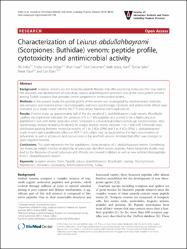| dc.contributor.author | Erdes, Efe | |
| dc.contributor.author | Doğan, Tuğba Somay | |
| dc.contributor.author | Cosar, İlhan | |
| dc.contributor.author | Danisman, Tarık | |
| dc.contributor.author | Kunt, Kadir Boğaç | |
| dc.contributor.author | Seker, Tamay | |
| dc.contributor.author | Özen, Can | |
| dc.date.accessioned | 2019-10-20T08:00:25Z | |
| dc.date.available | 2019-10-20T08:00:25Z | |
| dc.date.issued | 2014 | |
| dc.identifier.issn | 1678-9199 | |
| dc.identifier.uri | https://dx.doi.org/10.1186/1678-9199-20-48 | |
| dc.identifier.uri | https://hdl.handle.net/11421/16068 | |
| dc.description | WOS: 000345796600001 | en_US |
| dc.description | PubMed ID: 25414725 | en_US |
| dc.description.abstract | Background: Scorpion venoms are rich bioactive peptide libraries that offer promising molecules that may lead to the discovery and development of new drugs. Leiurus abdullahbayrami produces one of the most potent venoms among Turkish scorpions that provokes severe symptoms in envenomated victims. Methods: In the present study, the peptide profile of the venom was investigated by electrophoretic methods, size-exclusion and reversed-phase chromatography and mass spectroscopy. Cytotoxic and antimicrobial effects were evaluated on a breast cancer cell line (MCF-7) and various bacterial and fungal species. Results: Proteins make up approximately half of the dry weight of L. abdullahbayrami crude venom. Microfluidic capillary electrophoresis indicated the presence of 6 to 7 kDa peptides and proved to be a highly practical peptidomics tool with better resolution when compared to conventional polyacrylamide gel electrophoresis. Mass spectroscopy analysis helped us to identify 45 unique peptide masses between 1 to 7 kDa with a bimodal mass distribution peaking between molecular weights of 1 to 2 kDa (29%) and 3 to 4 kDa (31%). L. abdullahbayrami crude venom had a proliferative effect on MCF-7 cells, which may be explained by the high concentration of polyamines as well as potassium and calcium ions in the arachnid venoms. Antimicrobial effect was stronger on gram-negative bacteria. Conclusions: This work represents the first peptidomic characterization of L. abdullahbayrami venom. Considering the molecular weight-function relationship of previously identified venom peptides, future bioactivity studies may lead to the discovery of novel potassium and chloride ion channel inhibitors as well as new antimicrobial peptides from L. abdullahbayrami venom. | en_US |
| dc.language.iso | eng | en_US |
| dc.publisher | Biomed Central LTD | en_US |
| dc.relation.isversionof | 10.1186/1678-9199-20-48 | en_US |
| dc.rights | info:eu-repo/semantics/openAccess | en_US |
| dc.subject | Scorpion Venom | en_US |
| dc.subject | Toxin | en_US |
| dc.subject | Peptide | en_US |
| dc.subject | Leiurus Abdullahbayrami | en_US |
| dc.subject | Microfluidic Capillary | en_US |
| dc.subject | Electrophoresis | en_US |
| dc.subject | Peptidomics | en_US |
| dc.subject | Venomics | en_US |
| dc.subject | Cytotoxicity | en_US |
| dc.subject | Antimicrobial Activity | en_US |
| dc.subject | Turkey | en_US |
| dc.title | Characterization of Leiurus abdullahbayrami (Scorpiones: Buthidae) venom: peptide profile, cytotoxicity and antimicrobial activity | en_US |
| dc.type | article | en_US |
| dc.relation.journal | Journal of Venomous Animals and Toxins Including Tropical Diseases | en_US |
| dc.contributor.department | Anadolu Üniversitesi, Fen Fakültesi, Biyoloji Bölümü | en_US |
| dc.identifier.volume | 20 | en_US |
| dc.relation.publicationcategory | Makale - Uluslararası Hakemli Dergi - Kurum Öğretim Elemanı | en_US |


















